| What is Kaggle?i’ve heard of it but i don’t know anythingi want to try but i don’t know how to startshould i join? |
While learning about machine learning and deep learning, there are probably more than a few people who have such questions and worries.
So this time, I will explain what kind of service Kaggle is, the benefits of Kaggle, and how to participate in Kaggle.
Please read to the end.
Table of Contents
- What is Kaggle?
- How Kaggle works
- Kaggle ranking
- Kaggle features
- Competitions
- Datasets
- Code
- Discussions
- Courses
- Benefits of joining Kaggle
- ① You can output your own learning
- ② You can learn the code of other participants
- ③ Touch various data
- ④ Earn prize money
- Getting started with Kaggle -How to register with Kaggle-
- ① Access the Kaggle site
- ② Click Register on the upper right
- ③ Create an account with Google Mail or your own email address
- ④ After completing the registration, check the user name and your profile URL
- ⑤ Agree to the handling of personal information
- Enter a Kaggle competition
- ①Check Overview
- ② Confirm data
- ③ Predict
- ④ Submission
- ⑤ Check your score
- 5 Recommended Books for Kaggle Study
- ① Data analysis technology that wins at Kaggle
- ② Kaggle start book starting with Python
- ③ Kaggle Competition Challenge Book
- ④Kaggle Tutorial
- ⑤ Learn by moving with Python! Introduction to Kaggle data analysis
- Summary
What is Kaggle?
In a nutshell, Kaggle is a machine learning competition service.
Compete on the accuracy of the model to be built against the theme provided by companies and universities. In other words, it is a place where data scientists can test their skills.
Kaggle is pronounced “Kaggle”. Participating players are called “kagglers”.
If you search for Kaggle, “Kaggle is meaningless” will appear in the search candidates. For those who are going to work on it, the motivation will go down.
There are three reasons why it is said that there is no point in participating.
Kaggle problems and actual practice may differ.In practice
, it is almost impossible to prepare beautiful data like Kaggle.
there are many
In other words, it seems to me that it is meaningless because it does not lead to practical work.
It is true that in practice, know-how other than analysis is necessary, but analytical skills are not easily acquired, so Kaggle is worth doing.
How Kaggle works
I will explain exactly how it works. Kaggle works in the following steps:
- Companies and universities provide challenges and datasets
- Participants analyze data and submit prediction results
- Automatic scoring by computer
- Participants repeat 2 and 3 during the competition to improve the accuracy of their model
- Ranking by score at the end of the period
- Top finishers win medals and prizes
Kaggle ranking
Kaggle ranks participants.
I will explain the conditions for each rank and rank for each category. This is the type of each rank and the corresponding number of people.
| Rank type | Applicable number of people |
| Novice | 92,453 |
| Contributor | 65,230 |
| Expert | 7,236 |
| Master | 1,669 |
| Grandmaster | 242 |
I will explain each rank.
Novice
Novice is a rank that you get when you join the community.
▼How to obtain
- register
Contributor
Contributor is a rank awarded to people who have completed their profile, engaged with the community, and understand the Kaggle platform.
▼How to obtain
- Add self introduction, place of residence and affiliation to your profile
- Account SMS Verification
- write a line of script
- Create a competition or submit a task
- leave one comment
- Upvote a discussion
Expert
A rank awarded to those who complete critical tasks on Kaggle in one or more categories of expertise. Once you reach the expert tier, you can participate in site-wide Kaggle rankings for that category.
▼How to obtain
- Competitions
2 bronze medals
- Datasets
3 bronze medals
- Notebooks
5 bronze medals
- Discussions
50 bronze medals
Master
A rank awarded to those who have demonstrated excellence in one or more categories of Kaggle expertise. You can participate in master-only competitions.
▼How to obtain
- Competitions
1 gold medal
2 silver medals
- Datasets
1 gold medal
4 silver medals
- Notebooks
10 silver medals
- Discussions
200 medals in all 50 silver medals
Grandmaster
A rank awarded to those who consistently demonstrate outstanding performance in one or more categories of Kaggle expertise to reach this highest tier.
- Competitions
- Gold in 5 gold medals solo
- Datasets
5 gold medals
5 silver medals
- Notebooks
15 silver medals
- Discussions
500 medals in all 50 gold medals
Kaggle features
Kaggle has five main features:
- Competitions
- Datasets
- Code
- Discussions
- Courses
I will explain each.
Competitions
This function allows you to participate in Kaggle competitions. All Kaggle participants compete against each other here.
Datasets
Ability to see and use different datasets.
You can aim to improve your ability to use datasets.
Code
A feature that allows you to search for machine learning code using Kaggle Notebooks.
You can learn better coding by looking at the code of various people and comparing the difference with your own code.
Discussions
This feature allows you to discuss with data scientists and machine learning engineers participating in Kaggle.
You can use it when you want to ask questions about things you don’t understand or participate in discussions about AI.
Courses
You can learn the knowledge necessary for AI development including Python.
You can learn not only programming but also SQL and natural language processing, so beginners to intermediate students should actively use it.
Benefits of joining Kaggle
Here are the main benefits of joining Kaggle: Broadly speaking, there are three advantages.
- You can output your own learning
- Learn code from other participants
- Access to various data
- earn a prize
① You can output your own learning
This is the biggest advantage. While learning machine learning and deep learning, I think there are more than a few people who have the problem of not knowing what level they have reached.
By participating in Kaggle, you can understand your current level. Among them, the quality of learning can be expected to improve by setting specific goals such as rankings and scores.
② You can learn the code of other participants
Kaggle has a team of talented machine learning engineers and data scientists, so the quality of submitted code is very high.
By referring to those codes, you can further brush up the models you have built.
Even if you are still a beginner, you can learn how to write code while watching other participants’ code.
③ Touch various data
Kaggle gives you the opportunity to interact with raw data. This is because real companies and universities provide challenges and datasets.
For example, students who are not actually working may use well-organized data for learning, but I think there are few opportunities to touch raw data.
By touching a wide variety of Kaggle data, you will acquire more practical skills.
④ Earn prize money
There are also prizes with a total prize of $ 10,000 (about 1.3 million yen). Some are worth tens of millions of yen. You have a lot of dreams.
Prizes are awarded to the top 3 and 10 finishers. If you place well, you can win big prizes.
Getting started with Kaggle -How to register with Kaggle-
I will explain how to register on Kaggle in 5 steps.
- Visit Kaggle site
- Click Register on the top right
- Create an account with Google Mail or your own email address
- After registration is complete, check your username and your profile URL
- Agree to the handling of personal information
I will explain each.
① Access the Kaggle site
First , go to the Kaggle site .

Click here for the Kaggle website
② Click Register on the upper right

③ Create an account with Google Mail or your own email address
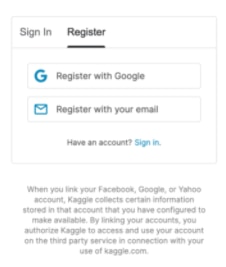
If you use a Google account, the account creation will be completed immediately. The username and password will be those of your Google account.
If you proceed by registering your email address, an email will be sent to the registered address and your account will be created. Set your username, display name, email address and password.
④ After completing the registration, check the user name and your profile URL
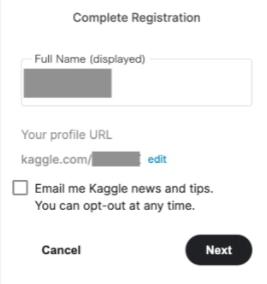
If there are no changes, press Next. Your registration is now complete.
Check the box if you would like to receive Kaggle news by email.
⑤ Agree to the handling of personal information
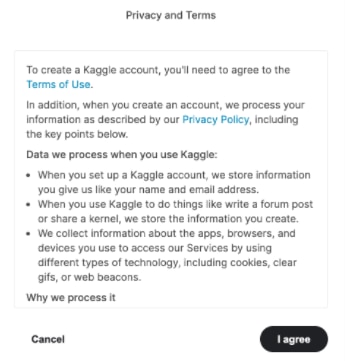
Kaggle may use data from companies and universities, so you need to agree to the handling of personal information.
After confirming, click the I agree part to complete registration and access My Page.
Enter a Kaggle competition
Next, I will show you how to participate in a real Kaggle competition in 5 steps.
- Check overview
- Confirm data
- make a prediction
- Submission
- Check your score
First of all, let’s participate in the Titanic competition recommended for beginners !
①Check Overview
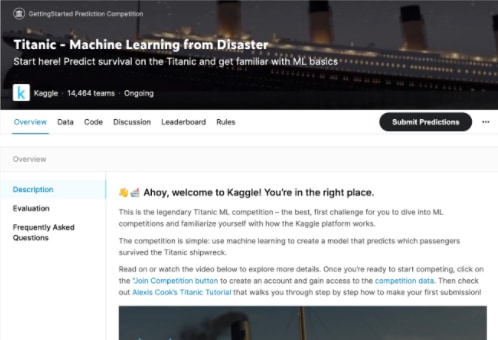
First, access the competition page and check the overview. Here you will find an overview of the data, types of data, submission methods, and evaluation criteria .
② Confirm data
Next, let’s check the most important data for analysis!
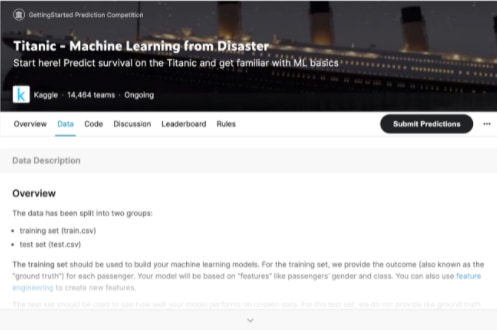
A more detailed data description is provided. Download the data here.
③ Predict
Based on the information in ①②, proceed with your own analysis.
If you don’t know how to proceed with the analysis, let’s refer to other users’ code published in “Code”!
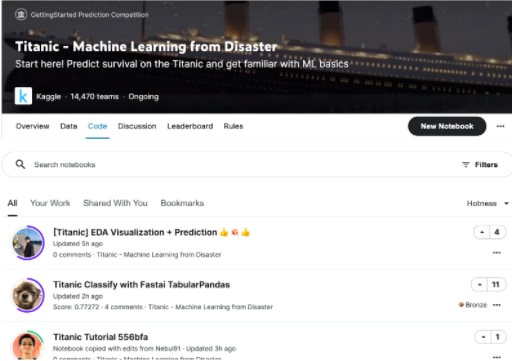
④ Submission
Click Submit Predictions.
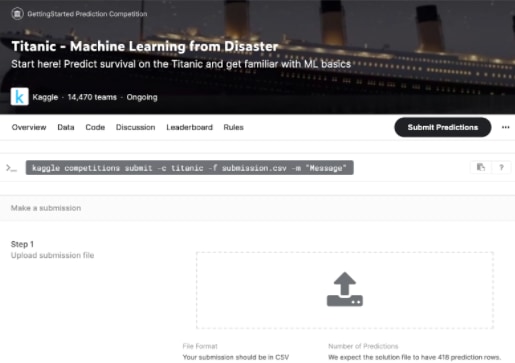
There are two ways to submit.
The first is to use kaggleAPI.

Submit the form using the command below. The “Message” section should contain a brief description of the submission.
The second method is to upload the file directly.

Select the files to be submitted in Step1. In the Step2 section, provide a brief description of your submission. Finally, click Make Submission to complete the submission.
⑤ Check your score
A score will be sent after submission, so aim for a good score by comparing it with other people’s code and referring to it to improve the quality of your analysis.
5 Recommended Books for Kaggle Study
In this chapter, we will introduce 5 recommended books for those who want to participate in Kaggle or want to study for Kaggle!
- Data analysis technology that wins at Kaggle
- Kaggle start book starting with Python
- Kaggle Competition Challenge Book
- Kaggle Tutorial
- Learn by moving with Python! Introduction to Kaggle data analysis
① Data analysis technology that wins at Kaggle
The latest information is organized and summarized at this time.
It describes techniques and points that are not often mentioned in general books, such as how to create features, validation, and parameter tuning .
Recommended for beginners who want to participate in Kaggle.
② Kaggle start book starting with Python
This is a book that explains how to prepare for winning at Kaggle for beginners.
It explains in detail how to win Kaggle so that you can go from being somewhat interested in Kaggle to being able to participate in the actual competition.
There is a detailed explanation of the sample code, so you can acquire the knowledge firmly. An easy-to-understand explanation is provided by the combination of the winning team and the professional Kaggler.
③ Kaggle Competition Challenge Book
“Kaggle Competition Challenge Book” is a book for Kaggle beginners.
Machine learning problems such as competitions dealing with tabular data and competitions dealing with audio/image data are explained in detail.
Each chapter looks at each competition in detail, from the competition introduction, organizer motivations, evaluation criteria, key approaches, data preparation methods, data analysis, and winner wisdom.
By running Python code used in past competitions, you can advance exploratory data analysis, learn machine learning models, and finally upload the results to Kaggle to see how your models perform better.
④Kaggle Tutorial
“Kaggle Tutorial” is a book that shows how to participate in machine learning competitions on Kaggle.
For beginners, we will carefully explain how to work on Kaggle’s Titanic competition.
The appendix also includes practical content for participating in the competition, such as the author’s experience of winning gold and silver medals, and reflections obtained after working on Kaggle for two and a half years.
⑤ Learn by moving with Python! Introduction to Kaggle data analysis
For those who want to start data analysis from now on, and data analysis beginners who are interested in Kaggle, this book carefully explains along with the actual Python code.
You can experience the process of actually solving problems by touching a part of data analysis and machine learning.
Kaggle’s tutorials for beginners “Titanic Competition” and “House Prices Competition” explain the process of preparing for analysis, considering results, and improving accuracy step-by-step with code in an easy-to-understand manner.
Summary
This time, I explained what its benefits and how to participate.
We hope that you will deepen your understanding of Kaggle even a little, and that it will be an opportunity to actively try Kaggle.

